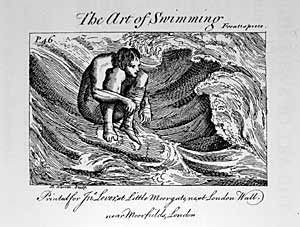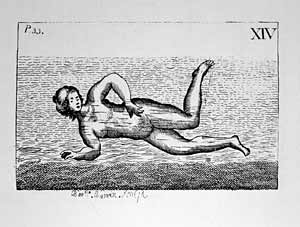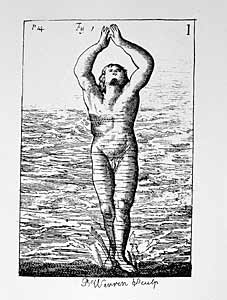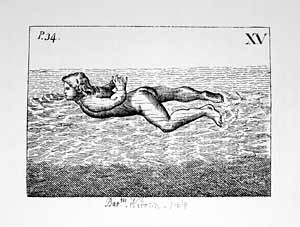Colonial Americans in the Swim
by Harold B. Gill Jr.

Dave Doody
Taking the part of William Byrd II, interpreter Noel Poirer enacts a scene from the great planter’s diary, indulging in a dip in the James attended by Donald Page in the role of body servant.
Time out of mind, people have escaped hot weather with a refreshing dip in the river, or a cool splash in a stream, or a soothing swim in a pond, or even a few strokes on the ocean. Swimming surfaces in literature at least as early as the Bible and Homer’s Odyssey. If it has ever been recognized for such practical applications as self-preservation and lifesaving, its exercise has long been valued for pleasure and for health-and sometimes for a mark of refinement. Witness John Locke, who, in Some Thoughts concerning Education, published in 1693, said every child should be taught to swim when old enough to learn and had someone to teach him. He wrote:
’Tis that saves many a man’s life: and the Romans thought it so necessary that they ranked it with letters, and was the common phrase to mark one ill educated and good for nothing that he had neither learned to read nor to swim. . . . But besides the gaining a skill which may serve him at need, the advantages to health, by often bathing in cold water during the heat of summer, are so many that I think nothing need to be said to encourage it, provided this one caution be used that he never go into the water when exercise has at all warmed him or left any emotion in his blood or pulse.
Like Locke, Benjamin Franklin thought every youth should learn to swim. In an undated letter written before 1769, Franklin said he believed
they would on many occurrences, be the safer for having that skill, and on many more the happier, as freer from painful apprehensions of danger, to say nothing of the enjoyment in so delightful and wholesome an exercise. Soldiers particularly should, methinks, all be taught to swim; it might be of frequent use either in surprising an enemy, or saving themselves. And if I had now boys to educate, I should prefer those schools (other things being equal) where an opportunity was afforded for acquiring so advantageous an art, which once learnt is never forgotten.
The Romans swam for recreation and for warfighting. Julius Caesar was noted for his swimming. Nicholas Orme wrote in Early British Swimming, 55 b.c.-a.d. 1719:
The writings of Rome in the classical era: history and biography, letters and poetry, include numerous mentions of swimming. . . . Swimming had high status as a healthy, manly and useful activity; it was thought of as essentially and traditionally Roman, and was traced back to the legendary hero Horatius Cocles who had swum the Tiber memorably after defending the bridge against the Etruscans.
In the Bible, the author of the Book of Isaiah, speaking of the downfall of Moab, writes: “And he shall spread forth his hands in the midst of them, as he that swimmeth spreadeth forth his hands to swim: and he shall bring down their pride together with the spoils of their hands.” The account of St. Paul’s shipwreck near Malta describes men swimming ashore while others clung to boards and other pieces of the ship to save themselves.

The frontispiece of the 1789 translation of Thévenot’s The Art of Swimming demonstrates how an expert sits in the water.
Tom Green
Shakespeare wrote about swimming. In Henry IV, Hotspur says: “If he fall in, good night, or sink or swim!” In Henry VIII, the cardinal mentions “little wanton boys that swim on bladders.” When Stephano, in The Tempest, asks Trinculo how he escaped the sinking ship, Trinculo says, “Swum ashore, man, like a duck; I can swim like a duck, I’ll be sworn.”
The 1726 British classic Gulliver’s Travels shows the hero considered himself a good swimmer and recites occasions when Gulliver found it convenient to swim.
Most of the early literary references have to do with people swimming to save their lives or with military engagements. But people swam for pleasure too, especially boys.
Francis Place’s autobiography says that during the summer boys often swam in the River Thames. He remembered that when he was about eleven, “I saw boys not older than myself swim across the Thames at Millbank at about half tide.” By 1743, recreational swimming was popular enough that the Peerless Pool was described as “an elegant pleasure bath,” 170 feet by 100 feet, with a smooth gravel bottom. It was accessed by
several flights of steps . . . adjoining to which are boxes and arbours for dressing and undressing, some of them open, some enclosed. On the south side is a neat arcade under which is a looking glass over a marble slab, and a small collection of books for the entertainment of the subscribers. . . . here is also a cold bath the largest in England. . . . The free use of the place is purchased by the easy subscription of one guinea per annum.
In 1741 another swimming pool was advertised in a London newspaper. It was near the London Infirmary and offered a “swimming bath which is convenient for swimming or for gentlemen to learn to swim in.” Instructors were available to teach gentlemen to swim.
References to people swimming in colonial Virginia usually instance occasions of necessity, not pleasure. Nicholas Cresswell, for example, said that during a trip on the Ohio in 1775 one of the canoes drifted across the river and “one of the Company swam across the River and brought her over.” But the year before, when he was in Barbados, Cresswell wrote, “Early this morning Bathed in the Sea, which is very refreshing in this hot Climate.”
As Franklin said, some enjoyed swimming for recreation. The number of coroner’s inquests conducted in colonial Virginia on the bodies of boys and young men who drowned while swimming suggests the practice was widespread. When George Washington was nineteen, someone stole his clothes while he was swimming in the Rappahannock River.
William Byrd II several times in his diaries mentioned swimming in the James River, and he occasionally coaxed visitors to join him. On June 15, 1711, he wrote, “I took a walk about the plantation and then swam in the river to wash and refresh myself.” On a trip to North Carolina in 1733, Byrd recorded for September 30th that:

“To swim neither on Back nor Belly . . . move your left hand as often as you see convenient, without either separating it far from your body, or sinking it.”
- Tom Green
This being Sunday, we were glad to rest from our labors; and, to help restore our vigor, several of us plunged into the river, notwithstanding it was a frosty morning. One of our Indians went in along with us and taught us their way of swimming. They strike not out both hands together but alternately one after another, whereby they are able to swim both farther and faster than we do.
Some Native Americans were adept, which drew comment from settlers in North and South America. The stroke the Indians employed as described by Byrd seems to be a crawl or perhaps a dog paddle. Byrd was evidently unfamiliar with that style, having practiced what appears to be a breaststroke. Of course, a crawl is faster than a breaststroke.
Tribes inhabiting areas without large rivers were apparently ignorant of the skill. In 1792, John Rogers told Governor Henry Lee why Choctaws lost so many men in a war with the Creeks at the time of the American Revolution. “The Choctaws laboured under a disadvantage which lost them many men,” he wrote, “which was the want of the art of swimming.” The Choctaws “were frequently overtaken on their retreat by superior numbers of Creeks, and cut to pieces upon the banks of large Rivers, or forced in & drowned.”
They were so sensible of their disadvantage that they conducted a “great Council” and decided “that the nation should all be learnt to swim.” Rogers reported that the entire nation spent the summer on the banks of a river, where “the men, women, and children were taught the art of swimming; they are now said to be equal to any nation in that art.”
Swimming for recreation was becoming more popular by the late seventeenth century. During the sixteenth century, Everard Digby wrote the first English treatise on swimming, De Arte Natandi, but it was in Latin and circulated narrowly. Digby thought it was appropriate for everyone to master the skill if for no other reason than personal safety.

“Of the manner of entering into the water” when your swimming is expert.
- Tom Green
In 1595 Christopher Middleton translated Digby’s work into English and entitled it A Short Introduction for to Learne to Swimme. Middleton intended to reach a wider audience than Digby and shortened and simplified the work.
A hundred years later, in 1696, The Art of Swimming was published in France. Three years later it was translated into English. The book proved popular, and a third English edition was published in 1789. The author, Melchisédech Thévenot, wrote that because a person is “near the like weight with water,” swimming is easy “insomuch that lying on his back without motion, and holding in his breath he cannot sink.” Thévenot details the mechanics of stroking:
The action of Swimming in Man, like a Boat with a pair of Oars, is nothing but a motion propagated by Vectes, whose Fulcrums are moveable. The consideration of human Bodies, of the management of their Arms and Legs, from the same Principles, in other Arts and Exercises, shew evidently to us the reasons of several strange and surprising actions, as in Wrestling, Fencing, &c. and at the same time might give us inlets to further and unthought-of Improvements.
As the cardinal speaks in Henry VIII of “little wanton boys that swim on bladders,” Thévenot also mentions swimming with bladders:
Besides the common helps of Cork and Bladders, &c. that young beginners make use of to learn, there might be invented several small Machines of different uses for different purposes. How easy, and at the same time how useful, might several Instruments be found out that were very little and easily portable, by which one might pass any River, or escape any danger of the water. Girdles of several sorts (whereof I hear of one lately invented, and very useful) might be made for such cases, of any Materials that are flexible and impervious to the water, such as oil’d Cloths, and several sorts of Leather. A Cylindrical Case made of oil’d Cloth, and kept open on the inside by Iron rings fastened in it at a moderate distance from one another, so that clapping them together it might go into one’s pocket, might be so contrived as to tye round one’s Waist, and fastened to keep the water out, and that alone would save from being drowned.
The terminology of swimming strokes did not become fixed until the nineteenth century, but Thévenot described some strokes commonly used today. He also called attention to what is still the safe way to enter the water: know the bottom. He described treading water, which he thought a useful skill. “It may also be very advantageous,” he wrote, “in case a man is obliged to save himself from some enemy pursuing, by leaping into the water in a dark night; for in that case, one may wait, without making any noise, till he is passed by, and then go again on shore.”
Much of Thévenot’s book is devoted to such movements as swimming with both feet out of the water, or “The shew out of the Water four Parts of the Body,” and to turns. But he described swimming strokes we might recognize and explained something like what we would call the sidestroke, which Middleton said was “a laborious” way of swimming but “swifter than any of the rest”:
Suppose you Swim on your Back or Belly, lower, or sink your side, and at the same time elevate your right one. In Swimming, when you are thus laid, move your left hand as often as you see convenient, without either separating it far from your body, or sinking it, perpetually striking it out, and retracting it, as in a right line on the surface of the water. Besides the pleasure of Swimming thus, you may also find an advantage by viewing as you please either side of a river, and that one side may rest while the other is employed.
Thévenot also described how to dog paddle:
You are not to imagine that this way is difficult, for it is so far from it, that several who never knew how to Swim before, by practising of it by chance, have kept themselves above water. To Swim like a Dog, you must elevate or lift up and depress one hand successively after another, and do the same also with your feet, only with this difference, that with your hands you must draw the water towards you, and with your feet drive it from you; you must begin with the right hand, and right foot, and afterwards with the left hand and foot, and so successively.
Thévenot thought a stroke he called The Creep was useful for extricating the swimmer from weeds. It is close to what is known today as the breaststroke:
The action of Swimming in Man, is very like the motion of Creeping in reptiles; as suppose a Snake, for example, who resting or stopping first, with his fore parts, draws the rest of the body towards them; and it is a way very serviceable to get clear of weeds. To practise it, being upon the belly, you cast your hands forwards, and your feet softly backwards, but close together, and thus you advance, extending your arms and hands as far from your breast as possible, your fingers close, and the palms of your hands a little bent, turned towards the bottom; for being in this posture, if you draw towards your breast with your hands and arms, the water that is before you, by that you give time to the rest of your body to advance further, and disengage yourself from the weeds.

“To swim on the Belly, holding both your hands still . . . you must keep your breast advancing forward, your neck upright.”
- Tom Green
Though the written record of recreational swimming in colonial Virginia is sparse and we don’t know if anyone in the colony owned a copy of Thévenot’s Art of Swimming or the other treatises, there is enough evidence to say that our ancestors enjoyed the sport. If Virginia summers were as warm in the eighteenth century as they are today, we can be sure many a person in a region so rich with rivers would refresh himself with a swim in the nearest flow of cool water.
Harold Gill, the journal’s consulting editor, contributed to the autumn 2001 magazine “Williamsburg and the Demimonde: Disorderly Houses, the Blue Bell, and Certain Hints of Harlotry.”
